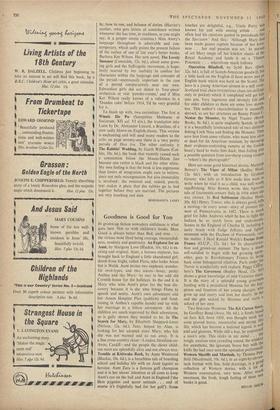Goodness is Good for You
IN grown-up fiction nowadays sinfulness is what goes best. Not so with children's books. Here Good is always better than Bad, and wins . . . the virtues most liked being courage, resourceful- ness, modesty and generosity. An Explorer for an Aunt, by Margaret Love (Blackie, 10s. 6d.) is ex- citing and original. Aunt, a famous explorer, has brought back to England a little abandoned girl, dumb from fright, called Flora, who looks Asian but is Welsh. Aunt invites two nephews, wonder- ful swot-types, and two nieces—bossy, pretty Anthea and shy Mary—to stay in her odd old Cornish house for the holidays. In the end it is Mary who wins Aunt's prize for the best dis- covery because it is she who brings Flora to speech and sanity. Aunt's own adventures and her Assam Hospital Plan (publicity and fund- raising in Anthea's capable hands) end up with her marriage to a fellow adventurer. All the children are much improved by their adventures, as is gaily shown they needed to be. In The Search for Mary, by Elisabeth Sheppard-Jones (Nelson, 12s. 6d.), Jane, helped by Alan, is looking for her adopted sister Mary, who felt she was not wanted and so ran away. It is a fine cross-country chase:—London, Stratford-on- Avon, Cardiff—and the people the clever child- ren meet are splendidly alive and not always nice. Trouble at Kittiwake Rock, by Anne Westwood (Blackie, 10s. 6d.), is a breathless tale of boarding school and holiday life with an Aunt (again) as heroine. Aunt Zara is a famous golf champion and it is her nieces' intention at all costs to keep Aunt's eye on the ball and Aunt in England ('she likes pygmies and queer animals . . . and of course it's frightfully bad for her golf'). Some
touches are delightful, e.g., 'Uncle Perry was
960 - ' known far and wide among artists . . and often had his opinions quoted in periodicals like the Spectator.' And this: 'Although Mary had been made games captain because of her keen- ness . . . her real passion was art.' In pursuit of art Mary snaps off her knicker elastic at the Royal Academy and lands it on a Tibetan Potentate . . . wherefrom much follows.
Operation Blindbell, by Sybil Burr (Dent' 12s. 6d.), is full of Scotch-American goodwill, but a little hard on the English (I have never met an English book which was hard on the Scots). The ,hero is a young American airman in a stiff cross' Scotland trial chase (mysterious clues, ten shillings only in pocket) which if completed will get hill into jets. Very ingenious and strongly felt arid for older children as there are some love stories, too. This author's characterisation is unusually shrewd, so are her strictures on Bonny Prince C. Nestor the Monster, by Nigel Tranter (Brock Books, 8s. 6d.), is quite unglumly Scotch, in fact it is a beautifully landscaped tale of two children fishing Loch Ness and finding the Monster. They save him from some villains, who want him alive or dead for an American museum, by throwing their evidence-containing camera at the foolish beast's head to make him duck, thus foiling als° a possible question from too-sharp young readers —'where's the photograph?' Here are some good historical stories. Marjorie Bowen's The Viper of Milan (Bodley Head, 12s. 6d.), with an introduction by Graham Greene, who tells us it first made him want to write when he read it as a child, was well worth republishing. Miss Bowen wrote this vigorous tale of fourteenth-century Italy in 1906 when she was sixteen. In Red Settlement (Bodley Head, 10s. 6d.) Henry Treece, who is always good. tells a moving—in every sense—story of pioneer life west of Pennsylvania in 1682. There is much grief for John Andrews when he has to fight the Indians he so much loves and understands. Scenes in the England of Charles II, including a nasty brush with Judge Jeffreys and lighter moments with the Duchess of Portsmouth, vary the matter. I liked Ronald Welch's Escape Iron, France (O.U.P., 12s. 6d.) for its characterisa- tion and grown-up manner. The hero, a shade self-satisfied to begin with but growing agree- abler, goes to Revolutionary France to bring back some beleaguered relatives. Paris under the Terror is wonderfully well realised. Peggy Olin' bers's The Governess (Bodley Head, 12s. 6d.) shows a great knowledge of mid-Victorian tittles' It is the story of a splendid young governess battling with a prejudiced Mamma for the hap. who piness and freedom of her young charges,
grow up and marry and love her dearly. In the end she gets sacked by Mamma and starts a school of her own.
Two first-rate Westerns. The Kit Carson SOO; based by Geoffrey Bond (Arco, 10s. 6d.), is firmly b
t, but, NI on fact. Kit, born 1809, was thought weak
soon proved brave, resourceful and strong. :ill
life, which has become a national legend, is told and glorious. While still a boy, he amputated the a man's arm. This sticks in my mind . • • rough, anxious men crowding round, the whisk°
for anaesthetic, the ignorant, brave boy With ti.lf knife (he had once seen the operation perform
eup Western Sheriffs and Marshals, by Thomas Pen" field (Macdonald, 10s. 6d.), in an eight-by-eleven'
inch format with fine, bold drawings, is a 804,
t
collection of Western stories, with a 10
Western conversation, very terse. After r
nocu
sweetness, the fresh, tough feeling of these
books is good. via°
STEVIE SI














































 Previous page
Previous page